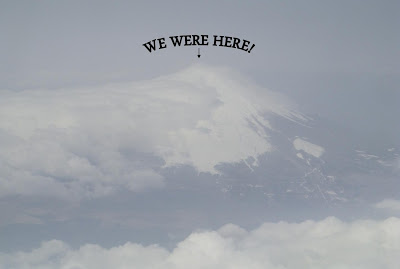 “No spot in this world can be more horrible, more atrociously dismal, than the cindered tip of the Lotus as you stand upon it. But the view—the view for a hundred leagues—and the light of the far faint dreamy world—and the fairy vapors of morning—and the marvelous wreathings of cloud: all this, and only this, consoles me for the labor and the pain….and the dust of these eyes be mingled with the dust of the myriad million eyes that also have looked in ages forgotten before my birth, from the summit supreme of Fuji to the Rising of the Sun.” — Fuji-No-Yama from “Exotics and Retrospectives” by Lafcadio Hearn, 1898
“No spot in this world can be more horrible, more atrociously dismal, than the cindered tip of the Lotus as you stand upon it. But the view—the view for a hundred leagues—and the light of the far faint dreamy world—and the fairy vapors of morning—and the marvelous wreathings of cloud: all this, and only this, consoles me for the labor and the pain….and the dust of these eyes be mingled with the dust of the myriad million eyes that also have looked in ages forgotten before my birth, from the summit supreme of Fuji to the Rising of the Sun.” — Fuji-No-Yama from “Exotics and Retrospectives” by Lafcadio Hearn, 1898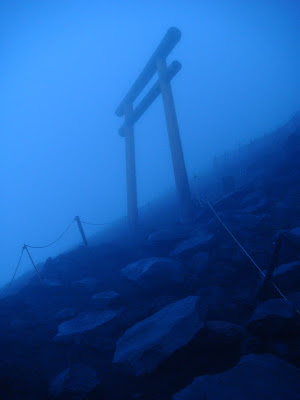 The darkness became less dark around 3:30am on July 4, 2010—Independence Day. What had been a vague outline of the trail became faintly clearer; the path ahead took shape and the snow patches glowed like sleeping ghosts sprawled on the alternating black and red of Fuji-san’s volcanic slopes.
The darkness became less dark around 3:30am on July 4, 2010—Independence Day. What had been a vague outline of the trail became faintly clearer; the path ahead took shape and the snow patches glowed like sleeping ghosts sprawled on the alternating black and red of Fuji-san’s volcanic slopes. 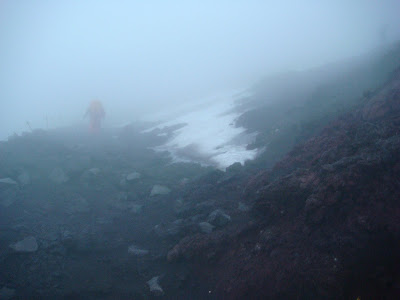
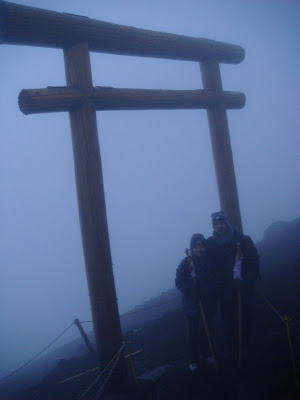 Along the final approach other hikers became visible in the lightening mist and we greeted each other, “Konnichiwa!” and “Ohayo gozaimasu!” Hello! Good morning! “Ganbatte!” Go for it! said the descenders to the ascenders. “Only 10 more minutes!”
Along the final approach other hikers became visible in the lightening mist and we greeted each other, “Konnichiwa!” and “Ohayo gozaimasu!” Hello! Good morning! “Ganbatte!” Go for it! said the descenders to the ascenders. “Only 10 more minutes!” 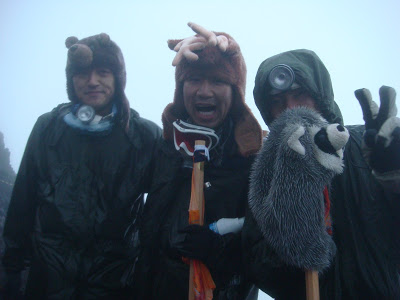 Multiple torii gates marked the summit as we arrived at the time of sunrise: 4:30am. I say the time of sunrise because we were surrounded in thick clouds and buffeted by whipping, icy winds. My pants, gloves, backpack—all soaked through by the blowing rain before we climbed above the clouds were now dusted with ice.
Multiple torii gates marked the summit as we arrived at the time of sunrise: 4:30am. I say the time of sunrise because we were surrounded in thick clouds and buffeted by whipping, icy winds. My pants, gloves, backpack—all soaked through by the blowing rain before we climbed above the clouds were now dusted with ice. 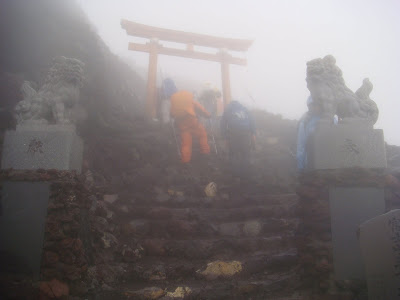 Climbing season officially began July 1, but none of the promised noodle stands at the top were open this early in the season. That’s ok—the winds were strong enough to forcibly push us around. Most of the crater rim trail was obstructed by snow and ice, so we walked down into it a little, then found this torii gate as the sun briefly pushed through the blowing icy mist for the first time. A gust of wind almost blew me through the torii gate. I bent down to collect some crater gravel for my sand collection, then rubbed my nose—ouch. Later I licked my lips and accidentally swallowed some tiny gravel; I think I ate a little bit of Mt. Fuji! Time to head back down! I was not sorry to leave that chilly mountaintop behind.
Climbing season officially began July 1, but none of the promised noodle stands at the top were open this early in the season. That’s ok—the winds were strong enough to forcibly push us around. Most of the crater rim trail was obstructed by snow and ice, so we walked down into it a little, then found this torii gate as the sun briefly pushed through the blowing icy mist for the first time. A gust of wind almost blew me through the torii gate. I bent down to collect some crater gravel for my sand collection, then rubbed my nose—ouch. Later I licked my lips and accidentally swallowed some tiny gravel; I think I ate a little bit of Mt. Fuji! Time to head back down! I was not sorry to leave that chilly mountaintop behind. 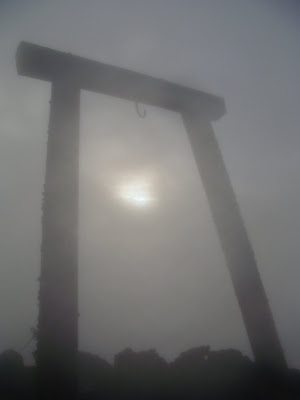
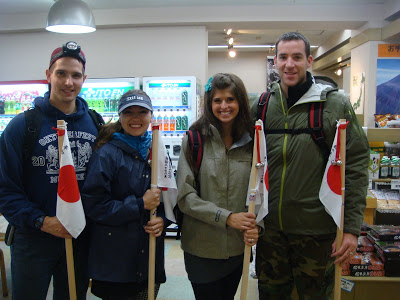 It was a dark and stormy night when Chris and I had left the Kawaguchiko fifth station with our friends the Holmans around 9:30pm July 3. That gave us plenty of time to arrive at the top for the sunrise. Several other groups were setting out at the same time under a light rain.
It was a dark and stormy night when Chris and I had left the Kawaguchiko fifth station with our friends the Holmans around 9:30pm July 3. That gave us plenty of time to arrive at the top for the sunrise. Several other groups were setting out at the same time under a light rain. 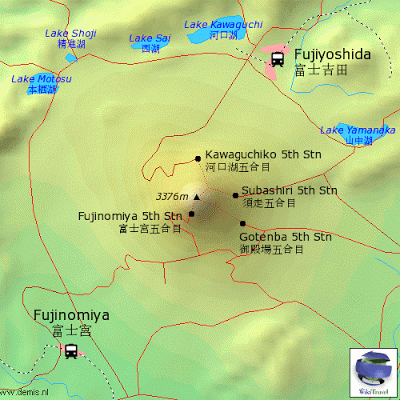
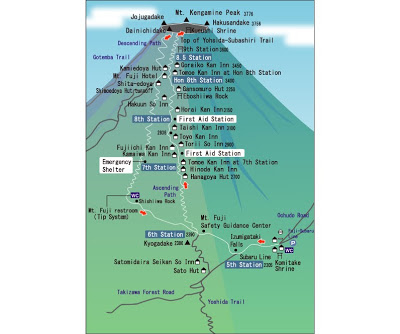 We were soon soaked despite all having waterproof or water-resistant stuff. The rain was relentless and as we got higher the wind joined in the effort to make sure we were thoroughly wet.
We were soon soaked despite all having waterproof or water-resistant stuff. The rain was relentless and as we got higher the wind joined in the effort to make sure we were thoroughly wet. 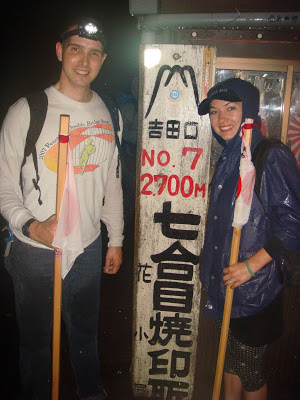 It was raining so hard any camera flash illuminated clouds of raindrops and nothing else. The wind blew Chris’ A&M hat over the side of the mountain even though he’d strapped a headlamp on over it. The headlamp landed on the side of the trail; the hat soared into the bottomless darkness.
It was raining so hard any camera flash illuminated clouds of raindrops and nothing else. The wind blew Chris’ A&M hat over the side of the mountain even though he’d strapped a headlamp on over it. The headlamp landed on the side of the trail; the hat soared into the bottomless darkness. 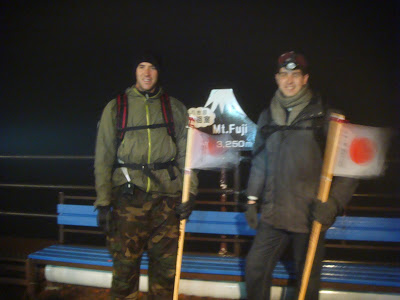 Between the slippery, jagged rocks, total darkness, an ice coating, slight altitude nausea and gusting winds there were some rough moments on that mountain in the middle of night. The lack of discernible sunrise didn’t even phase us that much—after a 7.5-hour ascent, we were just happy to be turning around.
Between the slippery, jagged rocks, total darkness, an ice coating, slight altitude nausea and gusting winds there were some rough moments on that mountain in the middle of night. The lack of discernible sunrise didn’t even phase us that much—after a 7.5-hour ascent, we were just happy to be turning around. 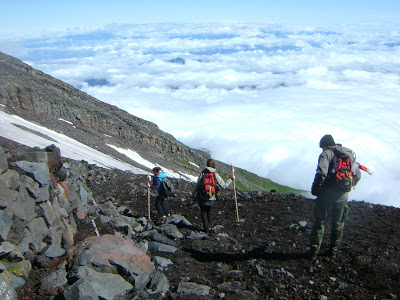 Once we got down past the worst of the whipping wind gusts the air cleared, visibility increased and the clouds puffed around exposed mountain peaks faaaaaaaar below us. Lake Yamanaka made an appearance. We could even see the green of Fuji-san’s lower slopes! Now this is what we’d hoped for! We parked it on the side of the trail and spread our raincoats over our backpacks to dry out a little before continuing the hike down. Gorgeous! As Daddy would say, “NOW we’re cooking with gas!”
Once we got down past the worst of the whipping wind gusts the air cleared, visibility increased and the clouds puffed around exposed mountain peaks faaaaaaaar below us. Lake Yamanaka made an appearance. We could even see the green of Fuji-san’s lower slopes! Now this is what we’d hoped for! We parked it on the side of the trail and spread our raincoats over our backpacks to dry out a little before continuing the hike down. Gorgeous! As Daddy would say, “NOW we’re cooking with gas!” 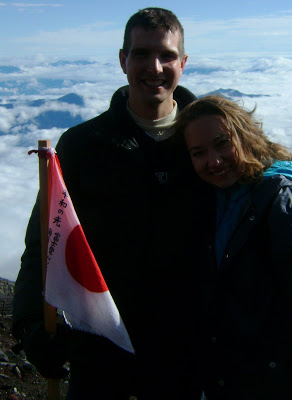
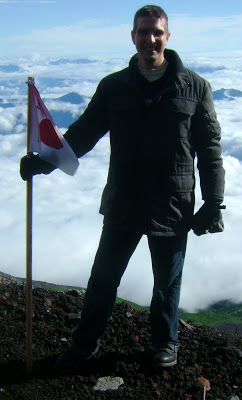
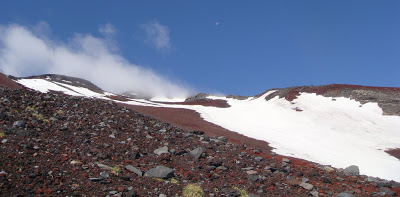 I looked back up toward the summit but its peak was still shrouded in roiling clouds. A morning moon hung poised over the peak. Thanks for nothing, Moon! We saw you for about 30 seconds total last night!
I looked back up toward the summit but its peak was still shrouded in roiling clouds. A morning moon hung poised over the peak. Thanks for nothing, Moon! We saw you for about 30 seconds total last night! 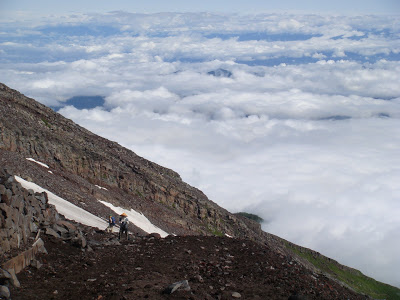 We’d been told to hike down the same trail we’d hiked up as far as the 8th Station. At the 8th Station we asked where to go and were directed toward the same descent—no fast way down for us. But this meant we could pass back through all the stations that were closed on our way up to get the obligatory “I wuz here” stamp branded onto our Japanese flag-topped hiking sticks. Neat! Plus we got to see all the other pilgrims headed toward the summit. We offered and received countless konnichiwas.
We’d been told to hike down the same trail we’d hiked up as far as the 8th Station. At the 8th Station we asked where to go and were directed toward the same descent—no fast way down for us. But this meant we could pass back through all the stations that were closed on our way up to get the obligatory “I wuz here” stamp branded onto our Japanese flag-topped hiking sticks. Neat! Plus we got to see all the other pilgrims headed toward the summit. We offered and received countless konnichiwas. 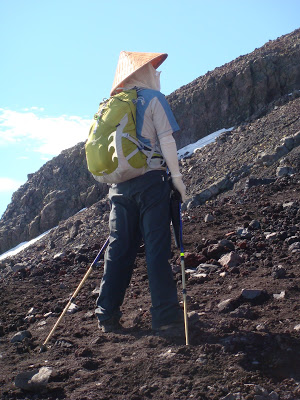 The Fuji-shaped hat and white cloth distinguish this guy as a pilgrim. Maybe. I read that somewhere. Otherwise it’s just a guy in a funny hat.
The Fuji-shaped hat and white cloth distinguish this guy as a pilgrim. Maybe. I read that somewhere. Otherwise it’s just a guy in a funny hat. 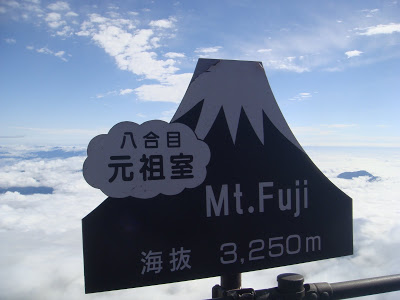 We ran into some nice Australian girls who were in Perth last year when Chris’ ship pulled in. One of them is Tinkerbell at Tokyo Disney! Can you guess which?
We ran into some nice Australian girls who were in Perth last year when Chris’ ship pulled in. One of them is Tinkerbell at Tokyo Disney! Can you guess which? 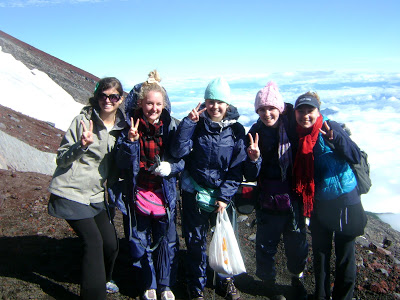
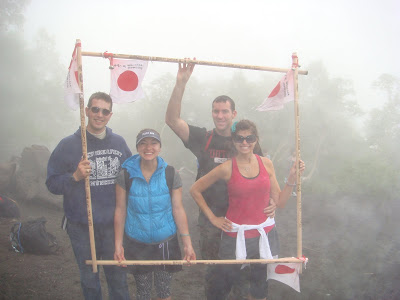 After our SEVEN HOUR descent we stopped for lunch of Fuji-shaped curry rice. Then we got stuck in a traffic jam on the Tomei Express (more like the Tomei Depress) for two hours, which was annoyingly symmetrical because on the drive to Fuji the exit was labeled differently on the sign than it had been on the map, so we went past it and had to drive—not kidding—35 minutes before there was another exit to turn around. Yaaaaay, driving in Japan. So 25 hours and one mountain after leaving Atsugi base, our foursome made it back. And we can check one more item off our Japan to-do list! (Note: the first snowy photo of this post was taken en route to Okinawa in March. The last photo of this post is Fuji from the base after lunch and shows an accurate amount of climbing season snow)
After our SEVEN HOUR descent we stopped for lunch of Fuji-shaped curry rice. Then we got stuck in a traffic jam on the Tomei Express (more like the Tomei Depress) for two hours, which was annoyingly symmetrical because on the drive to Fuji the exit was labeled differently on the sign than it had been on the map, so we went past it and had to drive—not kidding—35 minutes before there was another exit to turn around. Yaaaaay, driving in Japan. So 25 hours and one mountain after leaving Atsugi base, our foursome made it back. And we can check one more item off our Japan to-do list! (Note: the first snowy photo of this post was taken en route to Okinawa in March. The last photo of this post is Fuji from the base after lunch and shows an accurate amount of climbing season snow)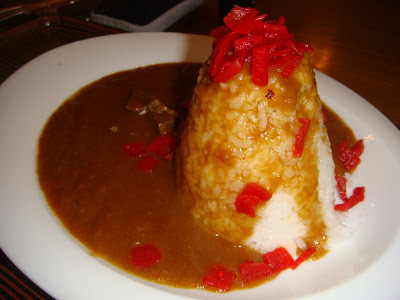 “A wise man climbs Fuji-san once, a fool twice.” —Japanese proverb
“A wise man climbs Fuji-san once, a fool twice.” —Japanese proverb 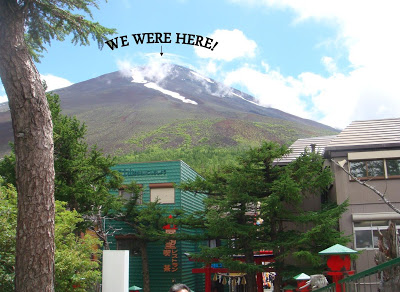
Fuji or Not Fuji
Recommended Reading:
Exotics and Retrospectives by Lafcadio Hearn
“The most beautiful sight in Japan, and certainly one of the most beautiful in the world, is the distant apparition of Fuji on cloudless days—more especially days of spring and autumn, when the greater part of the peak is covered with late or with early snows. You can seldom distinguish the snowless base, which remains the same color as the sky: you perceive only the white cone seeming to hang in heaven; and the Japanese comparison of its shape to an inverted half-open fan is made wonderfully exact by the fine streaks that spread downward from the notched top, like shadows of fan-ribs. Even lighter than a fan the vision appears—rather the ghost of dream of a fan; yet the material reality a hundred miles away is grandiose among the mountains of the globe. Rising to a height of nearly 12,500 feet, Fuji is visible from 13 provinces of the Empire. (Fuji-No-Yama, 1898)”
